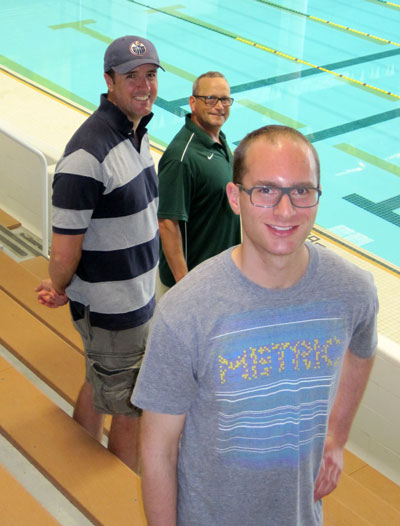
Master's student Will Lampe, seen here with professor Michael Kennedy and coach Bill Humby, explored blood pressure responses in trained athletes. What he's found will help coaches and trainers to better monitor fatigue in their athletes and individualise training regimens to mitigate its impacts.
For over 150 years, physiologists have been aware of a condition called orthostatic hypotension, commonly known as a dizzy spell caused by low blood pressure. Initial orthostatic hypotension (IOH) occurs when there's a significant drop in blood pressure when we rise quickly from a prone position; blood pools in the lower extremities and we feel dizzy and light-headed as a result. If the blood pressure drop is significant, it can even cause a loss of consciousness. And while this condition is a well-documented and researched phenomenon in clinical populations, and in old and young people in which it's prevalent, it hasn't been studied in high performance athletes - until now.
This is where master's student Will Lampe comes in. Working with Michael Kennedy, a professor of athlete health, Lampe has been testing Bears and Pandas swimming teams, applying the classic orthostatic challenge: lie supine for five minutes, come to an active standing position and then stand upright for three minutes; blood pressure is measured throughout the test.
"We wanted to see how the autonomic nervous system responded (to this test) because by looking at athletes' blood pressure and all the derived measures - such as heart rate, systolic and diastolic blood pressure, and stroke volume, among others - we are able to form a more complete picture of what is going on in the nervous system," explains Lampe.
That's important, he adds, because, "When an athlete goes from adapting well to training to becoming more fatigued, over-reaching and eventually to overtraining there are distinct shifts in the balance of the nervous system. So if we can quantify what's happening in the nervous system of the athlete then we can track them and see how they are responding to the training - and know when and how to intervene."
Head coach of the varsity swim team, Bill Humby, says the knowledge is valuable on many fronts. "From an athlete's perspective the benefit of the regular monitoring is that they get a better understanding of where they are at physically. They fill out their fatigue questionnaire and then can see how in-tune they are to their body by seeing their heart rate response," he says.
"It gives coaches a good sense for how the athletes are responding to the training as a group; for individuals the testing helps to identify the outliers, those that look particularly "different" from the group. When we look at the data sometimes we will push ahead as that is really where we thought they were and should be at the moment. But if we think the athlete is getting too far down the well, we will modify training or allow time off for recovery. I think it is the perfect blend of using science to help with the art of coaching. "
Lampe finds working with elite athletes interesting because "…they have more flexible arteries and therefore the blood rushes to their lower limbs more quickly than in a normal person. So they have a greater challenge trying to maintain their blood pressure when they stand up (after lying supine)," says Lampe, whose work with the varsity team earned him the 2012 Sport Medicine Council of Alberta Sport Science Excellence Award.
Some of this research he conducted and presented at the annual American College of Sports Medicine Conference in San Francisco this year looked at the incidence of IOH in endurance-trained swimmers and involved 10 male high performance swimmers on the Bears varsity team. "I was intrigued to find that 80 per cent of the swimmers had initial orthostatic hypotension when they stood up. That's a huge incidence of this clinical condition and it seems to be higher than what's reported in other populations."
One of the reasons for this, Lampe says, "… may have to do with the body position in which they're training - horizontal, versus an athlete who trains upright, like a runner. It makes intuitive sense that the exercising while supine over years has created a different sensitivity of controlling blood pressure compared to upright athletes because blood returns to the heart more efficiently and that is different from training without the assisted blood return."
Kennedy says what's been learned by their work with the swim team and Lampe's recent research has significant implications for athlete training in the future. "Will's work has provided some ideas about how we might use blood pressure responses to understand the nervous system in fatigued and non-fatigued states, changing our understanding of how to better monitor athletes' fatigue. This (work) has the potential to change the science of fatigue management in athletes and not just in swimming."
For Humby, the testing opens up important communication avenues between athlete and coach. "It allows us to ask them how they're feeling, how they think they are responding and what else is going on that might be affecting their recovery. In the end, I think we have been able to train pretty darned hard without losing anyone to overreaching."